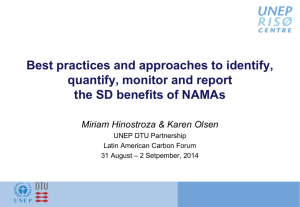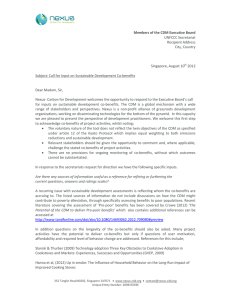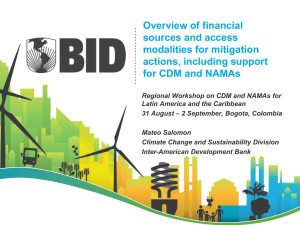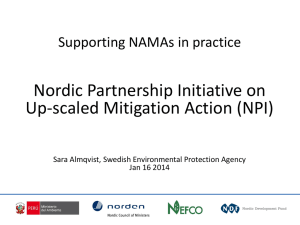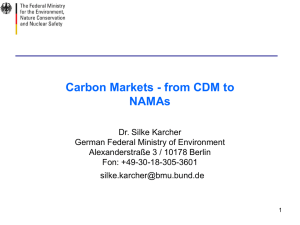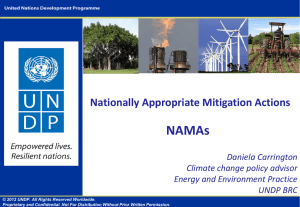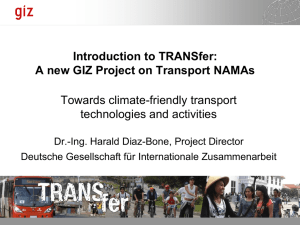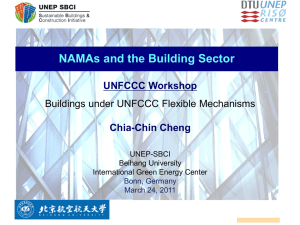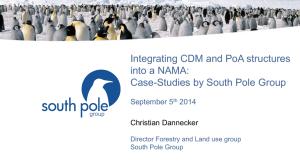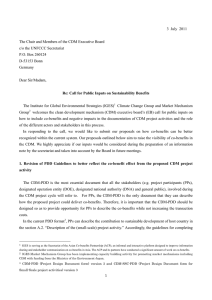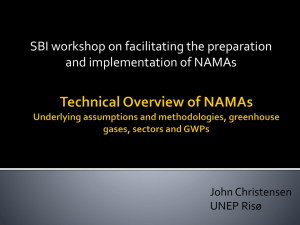UNEP_DTU_Co-benefits
advertisement
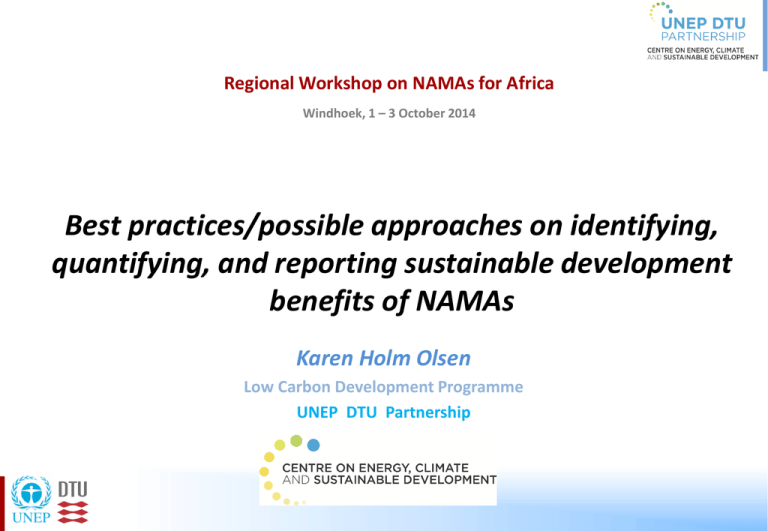
Regional Workshop on NAMAs for Africa Windhoek, 1 – 3 October 2014 Best practices/possible approaches on identifying, quantifying, and reporting sustainable development benefits of NAMAs Karen Holm Olsen Low Carbon Development Programme UNEP DTU Partnership Outline: • Issues and challenges • Overview of approaches to measure SD benefits: • • • • CDM SD tool A co-benefits approach to NAMAs Development Impact Assessment (DIA) Visual Methods to quantify/monetize the SD co-benefits – by the Gold Standard & South Pole • Examples • An expanded CDM SD tool analysis applied to NAMAs • NAMA SD evaluation tool by MDG Carbon/South Pole Issues and Challenges • Development First! “We should cooperate in achieving the peaking of global and national emissions as soon as possible, recognizing that the time frame for peaking will be longer in developing countries and bearing in mind that social and economic development and poverty eradication are the first and overriding priorities of developing countries and that a low-emission development strategy is indispensable to sustainable development” (Source: 2/CP.15, paragraph 2) • How to identify, design and assess the SD co-benefits of NAMAs to achieve the most development benefits? • How to ensure private and civil society stakeholder involvement in government-driven NAMAs? • How to MRV the impacts of GHG reductions and co-benefits for transformational change towards low carbon and sustainable development? Overview of approaches to measure SD co-benefits – CDM and NAMAs CDM SD Tool Source: Approved at CDM EB70: https://www.research.net/s/SD_tool_vers7 Example of SDC report: - air quality Improved cook stoves programme in India A co-benefits approach Source: Dubash et. al. (2013): “Indian Climate Change Policy. Exploring a Co-benefits Based Approach”, Economic & Political Weekly, June 1, 2013 Example of co-benefit assessment DIA Visual Source: Cameron et al. (2014): “Visualising Development Impacts: Experiences from country case studies.” Conference Paper, MAPS, January 2014, Cape Town Gold Standard –valuation of co-benefits Source: The Gold Standard, (2014): “The real value of robust climate action”. A Net Balance Report for the Gold Standard Foundation Method of valuation – benefit transfer • • • Valuation and monetisation are assumed to bring interesting perspectives and new angles to assess the merits of mitigation actions and how to manage them Non-market valuation techniques remain the only currently widely accepted way to put a value on intangible benefits ‘Benefit transfer’ requires a strict control of the similarity between the two environments, where the value is transferred and is based on case by case studies South Pole –monetizing approach to waste sector NAMAs Mitigation actions are driven by sustainable development benefits that need to be monetized: • Identify who is willing to pay for the SD co-benefits • Determine the willingness to pay per unit of created co-benefit • Facilitate a transaction of this willingness to pay to the producer of the co-benefits “Willingness to pay” for co-benefits is determined as the existing spending within the current public budget or if privately generated through private spending. Source: Draft discussion paper presented at side event in Bonn, 7 June 2014 titled: ‘Quantifying and monetizing NAMA co-benefits’ Example 1: CDM SD Tool applied to NAMAs An integrated approach Three elements: 1) SD indicators , 2) Stakeholder involvement procedures, 3) Safeguards against negative impacts Example 2: NAMA SD evaluation tool The Tool is an Excel work book with eight sheets: Sheet Description SDGs & target Sustainable Development Goals (SDGs) and targets are future global priorities for sustainable development. The tool makes a link between the NAMA indicators and global targets. Instructions The first sheet describes the eight components of the tool SD evaluation The SD co-benefits are quantified based on a baseline value, an intervention value and a target value for each indicator. The score is expressed as Nationally Appropriate Improvements (NAIs) that can be positive or negative. Selection of indicators SD indicators are selected specific to each NAMA intervention. A NAMA may consist of several interventions. MRV MRV is based on interventions for NAMA implementation. Three sheets provide formats for: 1) Parameter selection for indicators, 2) MRV of the intervention and 3) Monitoring format for each intervention, indicators and parameters Source: The tool is available online here www.undp.org/content/undp/en/home/librarypage/environment-energy/mdgcarbon/NAMA-sustainable-development-evaluation-tool. By MDG Carbon and South Pole NAMA PARTNERSHIP WEBSITE http://www.namapartnership.org/ Thanks!
